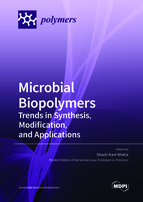Microbial Biopolymers: Trends in Synthesis, Modification, and Applications
A special issue of Polymers (ISSN 2073-4360). This special issue belongs to the section "Biomacromolecules, Biobased and Biodegradable Polymers".
Deadline for manuscript submissions: closed (5 March 2023) | Viewed by 33157
Special Issue Editor
Interests: biocatalysis and enzyme engineering; biofuel; biomaterial; biochemical engineering; antibiotics; metabolic engineering; glycosylation; bioencapsulation; mutagenesis; protein purification; molecular biology
Special Issues, Collections and Topics in MDPI journals
Special Issue Information
Dear Colleagues,
Microbes can act as a factory for the conversion of a variety of carbon and nitrogen sources into diverse kinds of intracellular and extracellular biopolymers including polyhydroxyalkanoates, polysaccharides, polyamides, polyphosphates, etc. These biopolymers have a diverse biological role in a microbial system such as reserve food material, pathogenicity, biofilm formation, and protection against adverse environmental conditions. Biopolymers have different chemical and morphological properties that make them suitable for industrial, environmental, and medical applications. Recent advances in molecular biology, transcriptomics, metabolomics techniques have improved the understanding related to mechanisms and regulations involved in biopolymer synthesis. A microbial system can be easily engineered and cultured under controlled conditions to produce desired polymers. Biopolymers produced by microbial systems are rich in various functional groups which can be exploited further to modify the polymers for a variety of applications. Biopolymer's production cost is the main challenge for its applicability at a commercial scale. Researchers are working on the utilization of diverse kinds of organic wastes such as lignocellulosic waste, municipal waste, whey, paper and pulp industry waste, etc. as feedstock for microbial fermentation. Biopolymer production from the microbial system is a clean and green approach and has recently become a hot topic around the globe and it is considered as a possible way to deal with plastic-based wastes and has tremendous applications in the biotechnology sector. Keeping in view the recent advances in microbial biopolymer production technologies, modification, and applications this special issue will include a series of review and research articles covering the following issue, but not limited to:
- Strategy for selection of novel biopolymer producer and improvement of existing microbes using a genetic engineering approach.
- Recent technological advancements in improved biopolymer production using pure culture or mixed culture.
- Utilize cheap and unconventional feedstocks for biopolymer production.
- Reactor design and improvements of the upstream and downstream process.
- Modification and fabrication of biopolymers for diverse applications
- Applications of biopolymers in health, food, environment, and other areas.
- Biodegradation of polymers
- Techno-economic analysis of biopolymer production.
Dr. Shashi Kant Bhatia
Guest Editor
Manuscript Submission Information
Manuscripts should be submitted online at www.mdpi.com by registering and logging in to this website. Once you are registered, click here to go to the submission form. Manuscripts can be submitted until the deadline. All submissions that pass pre-check are peer-reviewed. Accepted papers will be published continuously in the journal (as soon as accepted) and will be listed together on the special issue website. Research articles, review articles as well as short communications are invited. For planned papers, a title and short abstract (about 100 words) can be sent to the Editorial Office for announcement on this website.
Submitted manuscripts should not have been published previously, nor be under consideration for publication elsewhere (except conference proceedings papers). All manuscripts are thoroughly refereed through a single-blind peer-review process. A guide for authors and other relevant information for submission of manuscripts is available on the Instructions for Authors page. Polymers is an international peer-reviewed open access semimonthly journal published by MDPI.
Please visit the Instructions for Authors page before submitting a manuscript. The Article Processing Charge (APC) for publication in this open access journal is 2700 CHF (Swiss Francs). Submitted papers should be well formatted and use good English. Authors may use MDPI's English editing service prior to publication or during author revisions.
Keywords
- biopolymer
- polyhydroxyalkanoates
- exopolysaccharides
- polyamides
- biodegradation
- techno-economic analysis







